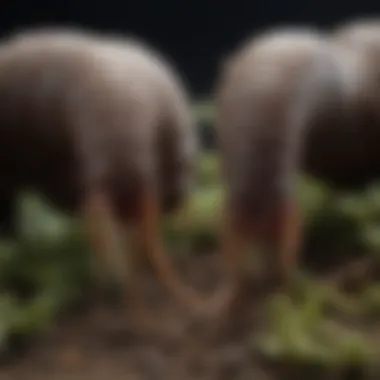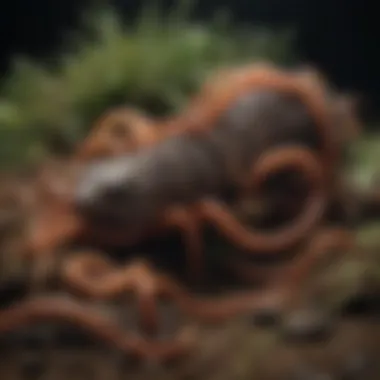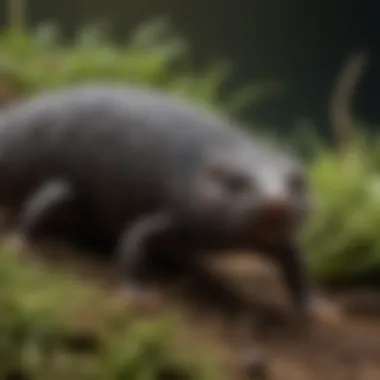Best Poison Worms for Moles: Effective Control


Intro
Moles, although often overlooked, are significant pests in many gardens and lawns. They can cause extensive damage to the root systems of various plants, leading to unsightly patches and potentially killing flowers or grass. Understanding the behavior of moles and learning about the effective methods to control their population is crucial for maintaining the integrity of your landscape. This article offers a comprehensive examination of the best poison worms available for mole control, looking closely at their efficacy, application methods, and safety considerations.
Identification of Common Pests
Description of Common Pests
Moles are small mammals with cylindrical bodies, velvety fur, and large front paws designed for digging. The most common species found in yards include the Eastern mole and the Western mole. These creatures thrive in environments with abundant earthworms and grubs, which comprise their primary diet. Their burrowing habit leads to the formation of raised tunnels and unsightly mounds of dirt, often creating an uneven surface in lawns.
Signs of Infestation
Identifying a mole infestation can be straightforward if you know what to look for. Key signs include:
- Raised tunnels in the soil, often visible when grass is pushed aside.
- Freshly displaced soil with no vegetation growing on it.
- Mounds of dirt that surface suddenly, indicating recent activity.
If you notice these signs repeatedly in your yard or garden, it may be time to consider more aggressive pest control methods, including poison worms.
Prevention Techniques
Home Maintenance Tips
To reduce the chances of a mole infestation, regular lawn maintenance is crucial. Here are a few practical steps:
- Maintain healthy grass to discourage mole-friendly pest populations.
- Aerate the soil to improve drainage, as moles favor moist conditions.
- Remove food sources like grubs by using appropriate pesticides.
Environmental Modifications
Making slight modifications in your garden can deter moles from making themselves at home. For example:
- Improve the health of your soil and plants to make them less attractive to moles.
- Apply barriers or fencing underground to protect particularly vulnerable areas of your garden.
Eco-Friendly Pest Control Options
Natural Pesticides
If you are concerned about the environmental impact of traditional poisons, consider utilizing natural pesticides. Substances like neem oil can repel moles without harming the ecosystem. This method ensures you maintain a healthy balance in your garden while preventing something like moles from overtaking it.
Organic Pest Control Techniques
Organic techniques may also include introducing natural predators into your garden. For instance, attracting owls can significantly help reduce mole populations. Setting owl nesting boxes can create a natural solution to pest control that avoids the use of poisons altogether.
Integrating a mix of methods, from home maintenance to eco-friendly controls, creates a sustainable way to manage gardens effectively.
By understanding gray areas between pest management and ecological fidelity, homeowners can protect their lawns without compromising environmental health.
Understanding Moles
Understanding moles is vital for effective pest control. Moles can cause significant damage to gardens and lawns. By knowing their biology and behaviors, homeowners can use targeted methods for their management. This section focuses on the essential elements that define moles, their habits, and how to identify if they are invading your space.
Biology and Behavior of Moles
Moles are small, burrowing mammals belonging to the family Talpidae. They have cylindrical bodies, velvety fur, and strong forelimbs adapted for digging. Moles primarily live underground, usually creating extensive tunnel systems. This behavior allows them to avoid predators, search for food, and maintain a stable environment.
Moles are insectivores, feeding mainly on earthworms, grubs, and insects. Their high metabolic rate requires substantial energy, so they constantly forage for food. Adult moles can consume up to 100% of their body weight per day. Understanding these behaviors is key to effective management, as their feeding habits directly impact the food sources available for other species in the garden.
Signs of Mole Infestation
Detecting a mole infestation is crucial for control efforts. Look for the following signs:


- Molehills: Small, conical mounds of dirt are created as moles push soil up while digging. These can be a clear indication of their presence.
- Tunnels: Shallow, raised ridges in the grass may indicate an extensive tunnel system below.
- Plant Damage: Moles can wreak havoc on root systems, leading to wilting or dying plants.
It is important to assess these signs properly. Early detection can make the difference in managing their population before extensive damage occurs. Taking note of active areas increases the success rate of control methods, including the use of poison worms designed specifically to target moles.
Types of Poison Worms Available
Understanding the types of poison worms is critical for anyone looking to effectively control mole populations. The effectiveness of these poisons varies based on their composition and method of action. Knowing the specific options available not only aids homeowners but also helps pest control professionals in making informed decisions. Careful selection is essential because the wrong choice can lead to ineffective results or unintended consequences.
Chemical Composition of Poison Worms
The chemical components of poison worms play a significant role in how they affect moles. Common active ingredients include bromethalin, warfarin, and zinc phosphide. Each ingredient has a different mechanism of action.
- Bromethalin: This neurotoxin disrupts the nervous system, leading to paralysis and ultimately death in moles.
- Warfarin: This anticoagulant affects blood clotting, which results in internal bleeding. Its effects may take longer to manifest, making it less preferred in quick extermination scenarios.
- Zinc Phosphide: When ingested, it reacts with stomach acid to release phosphine gas, which is highly toxic. This makes it particularly effective for rapid results.
Considering the chemical composition can inform users about which poison will be best for their specific situation, especially regarding the urgency of mole control needed.
Types of Poison Worms
There are several formulations of poison worms available in the market. They can primarily be categorized into bait blocks, gel formulations, and powder forms. Each type has its own unique benefits and application requirements:
- Bait Blocks: These are pre-formed bait that require minimal preparation. They can be placed directly into mole tunnels. Their durability is beneficial in areas prone to wetness or moisture.
- Gel Formulations: Gel poisons are often preferred because they can be easily applied to bait stations in active tunnels. The gel format allows for a more targeted approach, ensuring the poison remains within the tunnels where moles frequent.
- Powder Forms: Powders can be spread over active mole paths or mixed into the soil. They may be less convenient to use but often offer a cost-effective solution.
Each type has its application methods and effectiveness, influencing homeowners' decisions on the best options.
Commercial Products vs. Homemade Solutions
When considering poison worms for moles, users often weigh the choice between commercial products and homemade solutions. Each approach has its pros and cons that should be considered carefully.
- Commercial Products: These are typically more consistent in effectiveness, as they are formulated to meet specific standards. They often require less experimentation and provide more reliable results.
- Homemade Solutions: These might be appealing due to cost savings. However, their effectiveness can be variable, and the risk of non-target species exposure is often higher. Home mixtures might not align with current safety and ecological guidelines.
For cautious users, commercial products provide assurance of quality, while the homemade route may risk not only efficacy but also safety. A well-informed choice between these methods can greatly influence the success rate of mole control efforts.
Effectiveness of Poison Worms
Understanding the effectiveness of poison worms is integral to any pest control strategy focused on moles. Effective mole control requires knowledge of how these substances work and the factors surrounding their use. Homeowners and pest control professionals must weigh the benefits of these products against potential drawbacks. Knowing how poison worms impact mole populations can lead to more informed choices, ultimately enhancing the strategies used for mole management in residential settings.
How Poison Worms Work
Poison worms utilize active ingredients to disrupt the biological functions of moles. These chemicals often target the nervous system or digestion of the mole, leading to incapacitation or death. When ingested, these substances act swiftly, reducing the mole population effectively. The speed of action is a major factor in their effectiveness. Generally, poisoning occurs without the moles being detected, which allows for their use in various terrains.
One notable example is the use of active substances like sodium nitrate. This compound, when consumed by moles, leads to a toxic reaction that significantly impairs their physiological processes. It's essential for homeowners to select poison worms that are especially effective against the species of moles prevalent in their areas. Additionally, appropriate application helps ensure a successful outcome.
Factors Influencing Effectiveness
Several factors can influence the effectiveness of poison worms in controlling moles. Here are some key considerations:
- Soil Type: The permeability and composition of the soil can affect how poison worms interact with the environment. Sandy or loose soils may allow for quicker dispersal of chemicals, while dense or clay-like soils may hinder effectiveness.
- Mole Species: Different species may react differently to specific formulations. Knowing the local mole species can guide the choice of poison worm products.
- Weather Conditions: Rain, temperature, and humidity impact the stability and potency of poison. For example, heavy rainfall can wash away poisons, reducing their availability to moles.
- Placement Strategy: Proper placement within active tunnels ensures that moles come into contact with poison worms. Incorrect placement can result in ineffective control measures.
Furthermore, the timing of application can enhance or diminish effectiveness. Applying during peak activity periods increases the likelihood of moles encountering the poison. These factors collectively shape the success of poison worms in mole control efforts.
"Understanding how poison worms work, and the variables affecting their efficiency is crucial for effective mole management."
Application Techniques
Application techniques are crucial when it comes to using poison worms for mole control. Proper methods not only maximize the poison's effectiveness but also minimize the risk to non-target species and the environment. Understanding where and how to apply these substances can significantly influence the outcome of pest control efforts.
Determining Placement of Poison Worms
Placement of poison worms is a key factor. Moles create extensive tunnel systems in search of food, mainly earthworms and grubs. Thus, identifying active tunnels is essential. Look for fresh dirt mounds or raised ridges, which suggest recent mole activity.


- Identify the active tunnels: Check for soft soil or recent disturbances.
- Insert poison worms near active areas: Situate them in areas where moles are likely to forage.
- Vary placement: If the initial application does not yield results, explore other sections of the lawn to account for different tunnels.
Timing of Application
Timing can serve as a decisive factor in the success of using poison worms. Moles are more active during specific seasons. Generally, spring and late fall are the seasons of heightened activity. During these periods, moles are busy feeding in preparation for winter.
- Apply the poison worms early in the day when moles are most active.
- Avoid rainy days since moisture can wash away the poison or dilute its effectiveness.
- Consider application after a period of disturbance, such as lawn aeration to displace moles.
Best Practices for Application
Employing best practices will enhance the overall effectiveness of mole control efforts.
- Wear gloves: Handle poison worms with gloves to avoid contamination.
- Follow product instructions: Read the product label thoroughly before application. Compliance ensures safety and effectiveness.
- Monitor results: Keep an eye on the areas where you've applied the poison. Check for any reduction in mole activity or new signs of damage.
Proper application is essential not only for effective control of moles but also to limit unintended effects on other wildlife.
Understanding and implementing these techniques accurately will streamline the process of controlling moles using poison worms, ultimately leading to a more effective pest management strategy.
Safety Considerations
Understanding the safety considerations when using poison worms for mole control is crucial for effective pest management. While these solutions can be beneficial in eliminating unwanted moles, they carry inherent risks that require careful attention. The primary focus of this segment will be on the potential hazards to non-target species and the critical measures to protect pets and children.
Risks to Non-Target Species
The use of poison worms poses a significant risk to non-target species, including beneficial insects, birds, and other wildlife. These organisms may inadvertently consume the poisoned worms or interact with the affected moles, leading to unintended consequences in the ecosystem. The prevalence of secondary poisoning is a particular concern, where predators that feed on poisoned moles also become vulnerable to toxicity.
To mitigate these risks, it is essential to select poison worms that specifically target moles while minimizing impact on non-target species. Reading the product label to understand the chemicals used is vital. Recognizing the local fauna is equally important. Homeowners should consider the types of wildlife commonly found in their area before opting for poison.
A few tips for ensuring safety include:
- Use poison worms in areas where non-target animals seldom roam.
- Follow all application instructions precisely to limit unintended exposure.
- Monitor the surroundings after application to observe any signs of wildlife being affected.
Protecting Pets and Children
When using poison worms, protecting pets and children is of utmost importance. Pets, such as dogs and cats, might be curious and could consume the poison or an affected mole. Children, being more vulnerable, might come into contact with these substances inadvertently, risking their health.
To ensure the safety of both pets and children, consider the following strategies:
- Strict Supervision: Always supervise pets and children when poison worms are in use. Ensure they do not access treated areas until sufficient time has passed for the poison to become ineffective.
- Secure Application: Apply poison worms in restricted areas. Fencing off the treated locations can help prevent pets from entering these zones.
- Proper Storage: Store poison worms in child-proof containers or cabinets, out of reach of curious children and pets. This minimizes the risk of accidental ingestion.
"The appropriate use of poison worms can improve pest control but poses risks that require vigilant management."
Understanding the importance of safety considerations not only aids in preventing accidents but also enhances the effectiveness of pest control efforts. Homeowners should stay informed and considerate about the implications of using poison worms while striving for a mole-free environment.
Environmental Impact of Using Poison Worms
The usage of poison worms in controlling mole populations carries significant implications for the environment. This topic is crucial as it involves balancing the immediate need for pest control with long-term ecological health. Understanding the environmental impact is essential for homeowners and pest control professionals. By being informed, they can make conscientious decisions that safeguard both their properties and local ecosystems.
Potential Ecological Risks
When utilizing poison worms, one must consider the potential ecological risks involved. These risks can affect various aspects of the environment:
- Non-target Species: Poison worms do not discriminate between moles and other soil-dwelling organisms. Beneficial insects and microorganisms, essential for soil fertility, may be affected. This can disturb local ecosystems and lead to imbalances.
- Bioaccumulation: Toxic substances can accumulate in the food chain. Predators that consume poisoned moles might face lethal consequences. This can have a cascading effect on wildlife populations, affecting species diversity.
- Soil Health: The introduction of chemicals into the soil can disrupt the delicate balance of nutrients and microorganisms. This may lead to reduced soil productivity and long-term degradation.
Taking into account these risks is vital before deciding to use poison worms. Homeowners need to weigh the benefits of mole control against the potential harm to surrounding wildlife and the broader environment.
Sustainable Pest Management Practices
To mitigate the environmental impact of poison worms, pursuing sustainable pest management practices is essential. These methods advocate for strategies that are not only effective but also environmentally responsible:


- Integrated Pest Management (IPM): This approach combines various control methods rather than relying solely on chemical solutions. By incorporating biological control, habitat manipulation, and cultural practices, IPM aims to achieve effective pest control while reducing risks to non-target species.
- Selective Application: When using poison worms, it's crucial to apply them selectively. By targeting areas with confirmed mole activity, homeowners can minimize unnecessary exposure to non-target organisms. This practice conserves beneficial soil inhabitants.
- Monitoring and Assessment: Regular assessments of mole activity can inform better timing and placement for poison worm applications. Continued monitoring helps adjust strategies based on the changing dynamics of pest populations and environmental health.
"Sustainable pest management practices not only target the problem of moles but also promote a healthier ecosystem overall."
- Educating the Public: Raising awareness about the implications of using poisons can lead to more informed decisions. Homeowners can be guided towards methods that are both effective and reduce environmental harm.
In summary, acknowledging the environmental impact of using poison worms is an integral part of effective pest management. By understanding potential ecological risks and pursuing sustainable practices, one can control mole populations responsibly.
Regulatory and Legal Considerations
Understanding the regulatory and legal framework surrounding the use of poison worms for mole control is critical. This knowledge impacts not only the effectiveness of pest management strategies but also ensures the safety and compliance with local laws. It is essential for homeowners to recognize that improper usage of any pest control methods can lead to legal repercussions, environmental harm, and unintended consequences on non-target species.
Understanding Local Regulations
Each region often has specific regulations regarding pesticide usage. Homeowners must be aware of these rules to avoid penalties. In some areas, certain poison types may be restricted or require permits for their application. Before purchasing any product, research local guidelines.
Some typical points include:
- Permitted products: Not all poison worm products are allowed everywhere. Check if specific brands meet local standards.
- Application restrictions: Certain times of year might impose limitations. Regulations can dictate when it's appropriate to apply these poisons.
- Notification requirements: Some jurisdictions may require informing neighbors prior to using any chemical pest control methods.
Failing to adhere to such guidelines can lead to fines, and more significantly, negative impacts on the surrounding ecosystem. Always keep up-to-date with any changes in legislation that might affect pest control options.
Product Registration and Licensing
The registration and licensing of poison worms indicate that the products meet safety standards set by regulatory authorities, ensuring they are safe for use in residential areas. Most reputable products will come with proper licensing from agencies like the Environmental Protection Agency (EPA) in the United States.
Key aspects to consider include:
- Product evaluation: Registered products should undergo rigorous assessment. This evaluation checks efficacy and potential environmental impact.
- Read labels carefully: The label contains vital information about application, safe handling, and risks. It's crucial to adhere strictly to these guidelines to use a product legally and safely.
- Licensing for professionals: Pest control professionals should have valid licenses to apply these products. Homeowners should inquire about this to verify their services.
By using registered and licensed products, homeowners can ensure compliance with regulations while minimizing risks associated with unregulated pest control methods. This attention to detail helps foster responsible pest management that aligns with both legal standards and ecological integrity.
"Knowing the rules not only protects you but also preserves the environment and ecosystem for future generations."
Evaluating Alternative Mole Control Methods
In the pursuit of effective mole control, it is essential to explore alternative methods beyond the use of poison worms. These alternatives not only offer diverse tactics but also foster a more balanced ecosystem in your garden or yard. Evaluating such methods can be beneficial for homeowners who prefer solutions that minimize environmental risk and protect non-target species. Alternative approaches can address mole populations while also ensuring the ecological integrity of the area. By understanding these strategies, homeowners can make informed decisions that align with their values and circumstances.
Non-Chemical Control Options
Non-chemical control options emphasize using natural methods to manage mole populations. These methods often require more patience and effort but can yield favorable results without harmful side effects. Some popular non-chemical techniques include:
- Soil Treatments: A healthy and well-maintained soil can discourage moles. Aeration of compacted soil can encourage natural insect activity that moles prey on.
- Planting Deterrents: Certain plants, such as daffodils, marigolds, and lavender, create a less inviting environment for moles. These plants can act as natural repellents while also beautifying the landscape.
- Vibrational Devices: Installing devices that create vibrations through the soil may irritate moles, persuading them to relocate. This method utilizes the natural behavior of moles to their detriment.
- Natural Predators: Encouraging animals like owls and hawks through habitat provisions can help maintain a balanced ecosystem. These predators may reduce mole populations without harming other wildlife.
Implementing these non-chemical control options can take time, but they often lead to sustainable outcomes, aligning with environmentally-conscious pest management philosophies.
Using Traps as an Alternative
Trapping moles is another effective method that provides immediate intervention without the risks associated with chemicals. It can be a hands-on procedure, but it offers high specificity, targeting only moles. When done correctly, trapping does not harm other wildlife.
- Types of Traps: There are various types of traps available, including scissor traps, harpoon traps, and expanse traps. Scissor traps are popular for their efficiency and reliability.
- Placement: Correct placement is crucial for success. Identify active mole tunnels by looking for fresh mounds of soil or sunken areas in your lawn. Set traps in areas where activity is evident.
- Baiting: While many traps do not require bait, some homeowners find that adding bait, such as peanut butter or earthworms, can increase effectiveness.
- Safety and Best Practices: Ensure to follow local regulations and guidelines when trapping. Additionally, methods must be used to protect children and pets, ensuring that traps are placed out of reach for safety.
"Understanding the behavior of moles and maintaining an ethical approach in pest control can lead to more sustainable solutions."
Culmination
In this article, we have explored the intricate landscape of managing mole populations through the use of poison worms. The effectiveness of these methods is contingent upon understanding not only the biology and behavior of moles but also the nuances of application and safety. The intersection of these factors reveals how critical informed choices are when it comes to pest control.
Summary of Key Points
- Understanding moles is essential for effective control, considering their behavior and signs of infestation.
- Various types of poison worms are available, along with commercial and homemade options.
- Application techniques significantly impact effectiveness—placement and timing are crucial.
- Safety considerations protect non-target species, pets, and children while using poison worms.
- The environmental impact is a major concern that necessitates sustainable practices when managing pests.
- Legal regulations govern the use of these products, and awareness of your locality's laws is important.
- Alternative mole control methods exist, such as traps and non-chemical solutions, offering diverse options for homeowners.
Final Recommendations
- Prior to using poison worms, it is advisable to assess the extent of the mole infestation and confirm the presence of moles.
- Always consider environmental impact; seek to minimize risks to your garden and non-target wildlife.
- Utilize best practices for application, ensuring correct placement and timing to maximize effectiveness while ensuring safety.
- Regularly consult local guidelines or professionals in pest management to ensure compliance with regulations.
- Explore alternative control methods alongside poison worms to create a more integrated approach to mole management.
By weaving together these insights, individuals can make informed decisions that align with both their pest management needs and ecological responsibilities.







